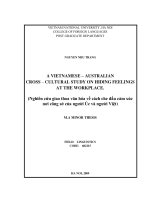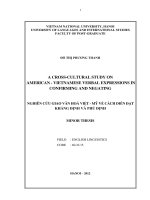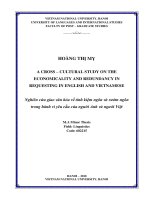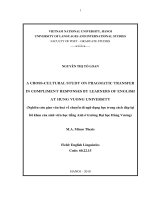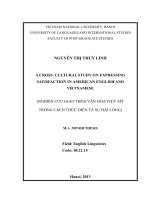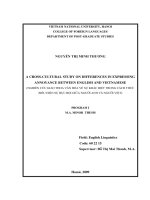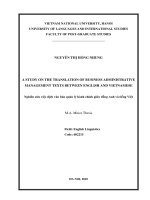a cross cultural study on expressing satisfaction in american english and vietnamese = nghiên cứu giao thoa văn hóa việt- mỹ trong cách thức diễn tả sự hài lòng
Bạn đang xem bản rút gọn của tài liệu. Xem và tải ngay bản đầy đủ của tài liệu tại đây (2.43 MB, 125 trang )
VIETNAM NATIONAL UNIVERSITY, HANOI
UNIVERSITY OF LANGUAGES AND INTERNATIONAL STUDIES
FACULTY OF POST-GRADUATE STUDIES
NGUYỄN THỊ THÙY LINH
A CROSS- CULTURAL STUDY ON EXPRESSING
SATISFACTION IN AMERICAN ENGLISH AND
VIETNAMESE
(NGHIÊN CỨU GIAO THOA VĂN HÓA VIỆT- MỸ
TRONG CÁCH THỨC DIỄN TẢ SỰ HÀI LÕNG)
M.A. MINOR THESIS
Field: English Linguistics
Code: 60.22.15
Hanoi, 2013
VIETNAM NATIONAL UNIVERSITY, HANOI
UNIVERSITY OF LANGUAGES AND INTERNATIONAL STUDIES
FACULTY OF POST-GRADUATE STUDY
NGUYỄN THỊ THÙY LINH
A CROSS- CULTURAL STUDY ON EXPRESSING
SATISFACTION IN AMERICAN ENGLISH AND
VIETNAMESE
(NGHIÊN CỨU GIAO THOA VĂN HÓA VIỆT- MỸ
TRONG CÁCH THỨC DIỄN TẢ SỰ HÀI LÕNG)
M.A. MINOR THESIS
Field: English Linguistics
Code: 60.22.15
Supervisor: Huỳnh Anh Tuấn, PhD
Hanoi, 2013
i
DECLARATION
I certify that this thesis entitled: “A cross- cultural study on expressing satisfaction
in American English and Vietnamese”, which is submitted in partial fulfillment of
the requirements for the degree of Master of Arts, is the result of my own work. I
have provided fully documented references to the work of others. The material in
this thesis has not been submitted for any other formal course of study.
Nguyen Thi Thuy Linh
Hanoi, 2013
ii
ACKNOWLEDGEMENTS
First and foremost, I would like to express my deepest gratitude to Mr.
Huynh Anh Tuan, PhD, my supervisor, for his valuable guidance, his instructive
comments and his dutiful supervision, without which this thesis would be far from
completed.
I would also like to give my sincere gratitude to all of the lecturers at HULIS- VNU,
Hanoi for their scholarly knowledge, experience, and enthusiasm in their lectures.
During the process of implementing the research, they have created the favorable
conditions for me, not only in terms of accessing to essential materials but also by
the heart-warming encouragement.
I also take this opportunity to express my immense thankfulness to my friends and
classmates, who have always stayed by my side, given me constructive comments
and perked me up every time I need. Particularly I want to say a special thanks to
two friends of mine, who are all living and studying in the U.S. for their invaluable
help in distributing the survey questionnaire. They are Le Huong Ly and Nguyen
Thi Lien Huong.
I cannot forget to acknowledge the important contributions of both Vietnamese and
American informants, whose names cannot be mentioned in the thesis.
Finally, I would like to express my enormous debt to my parents for their continual
encouragement and immeasurable support.
iii
ABSTRACT
Based on the theoretical background of cross- cultural communication, this study
aims at investigating the similarities and differences in expressing satisfaction
towards different co- interactants in the Vietnamese and American language and
culture. It focuses primarily on:
The popularity of strategies of expressing satisfaction employed
The use of directness and indirectness in expressing satisfaction
To succeed in doing such a research, the author of the study takes informants’ social
parameters such as age, sex, marital status, living area, and knowledge of foreign
language(s) into consideration. Besides, their survey responses are carefully
analyzed to build a frame, a common set of strategies in the field.
The conclusion is drawn from data analysis and findings are presented and
compared in a brief and concise way. Some common expressing satisfaction
patterns in both Vietnamese and American cultures from the data are also presented
and illustrated with the hope of partially helping avoid cultural conflicts or
communicating breakdowns.
iv
LIST OF TABLES AND FIGURES
Table 1:The five general functions of speech acts (Yule)
Table 2: Number of informants with their status parameters
Table 3:D-ID in the situations under study (in Vietnamese)
Table 4: Use of D-ID as seen from Vietnamese communicating partners‟ parameters
Table 5:D-ID in the situations under study (in American)
Table 6:Use of D-ID as seen from American communicating partners‟ parameters
Table 7:Use of D-ID as seen from Vietnamese informants‟ parameters
Table 8:Use of D-ID as seen from American informants‟ parameters
Table 9:Use of strategies as seen from Vietnamese communicating partners‟
parameters
Table 10:Use of strategies as seen from American communicating partners‟
parameters
Figure 1: Ferrando‟s diagram of culture
Figure 2: Nguyen Quang‟s diagram of components of communication
Figure 3: Areas of language knowledge (Bachman and Palmer, 1996:68)
Figure 4:: Bach and Harnish‟s classification of speech acts (1979)
Figure 5 : Possible strategies for doing FTAs
Figure 6: Nguyen Quang‟s schema of possible strategies for doing FTAs
Figure 7: Kaplan‟s diagram
v
TABLE OF CONTENTS
PART A: INTRODUCTION
1. Rationale 1
2. Aims of the study 2
3. Scope of the study 3
4. Methods of the study 3
5. Design of the study 3
PART B: DEVELOPMENT
Chapter 1: Theoretical background and literature review 5
I. Theoretical background 5
1. Culture and communication 5
1.1. Culture 5
1.2. Communication 9
1.3. Culture- communication correlation 12
1.4. Cross- cultural communication 13
1.5. Communicative competence 16
2. Cross- cultural pragmatics 19
3. Speech acts 21
3.1. The notion of speech acts 21
3.2. Classification of speech acts 22
3.3. Expressing satisfaction as a speech acts 25
4. Politeness 26
4.1. Face and politeness 26
4.1.1. Face 26
4.1.2. Politeness 28
4.2. Positive politeness strategies 30
4.3. Negative politeness strategies 33
vi
5. Directness and indirectness 35
5.1. Directness and indirectness defined 35
5.2. Levels of indirectness 37
5.3. Directness and indirectness in correlation with politeness 39
5.4. Social factors influencing the use of directness and indirectness in human
interaction 41
Chapter 2: Methodology 44
1. Research questions 44
2. Data collection instruments 44
2.1. The questionnaire 44
2.2. The informants 46
3. Data collection and analysis method 47
Chapter 3: Data analysis: Findings and discussion 48
1. Data analysis of D- ID in expressing satisfaction 48
1.1. D-ID strategies in expressing satisfaction 48
1.2. Use of D- ID as seen from communicating partners’ parameters 50
1.2.1. Vietnamese findings 50
1.2.2. American findings 51
1.2.3. Similarities and differences 53
1.3. Use of D-ID as seen from informants’ parameters 55
1.3.1. Vietnamese findings 55
1.3.2. American findings 56
1.3.3. Similarities and differences 57
2. Data analysis of strategies in expressing satisfaction (SES) 59
2.1. Strategies in expressing satisfaction 59
2.2. Realization of SESs in Vietnamese 60
2.2.1. Realization of SESs in Vietnamese as seen from co- interactants’
parameters 60
2.2.2. Realization of SESs in Vietnamese as seen from informants’ parameters 71
2.3. Realization of SESs in English 76
vii
2.3.1. Realization of SESs in English as seen from co- interactants’ parameter 76
2.3.2. Realization of SESs in English as seen from informants’ parameters 85
2.4. Similarities and differences 90
PART C: CONCLUSION
1. Summary of the study 93
2. Limitations of the study 95
3. Suggestions for further study 96
REFERENCES 97
APPENDICES I
1
PART A: INTRODUCTION
1. Rationale
With the great speed of developing and expanding, English has emerged as the most
powerful international language all over the world. Starting from its use gradually
turning into colossal, plus the characteristics of convenience, English on those days
can be said to be the “golden key to every door”.
In the Vietnamese context, as a result of the open policies and a lot of
encouragement and support from society, the needs of learning English have also
been magnified. However, for the sake of examination, the real purpose of learning
English has been somehow distorted. A long time ago, the method of English
teaching at school was Grammar- Translation Method with the stress on
grammatical points. Up till now, thanks to the attentive researches from language
teachers and educators, the pendulum of English language teaching has swung to
communicative approach. Acquiring a new language means a lot more than the
manipulation of syntax and lexicon. Language is not just a system of sounds, words
and grammatical structures in isolation, yet it is seen as a system of communication
existing in a community. The goal of language teaching is, therefore assumed to be
learners’ ability to communicate in the target language.
As a matter of fact, to attain the good command of communication, culture learning
apparently becomes indispensable. Brembeck (1977) noted that, “To know another‟s
language and not his culture is a way to make a fluent fool of oneself”. It is the
same in the case of teaching and learning English. In order to help learners achieve
communicative competence, we have to pay close attention to culture awareness
and acquisition. That dialectical connection has always been a concern of
researchers and from time to time it has received more and more agreement.
Thomas (1983) states that the lack of socio linguistic competence results in
rudeness, miscommunication or even communication breakdown because non -
native speakers’ inappropriate use of cultural norms and conventions are considered
2
as manifestation of “impoliteness or unfriendliness” due to “boorishness or ill will”
rather than lack of pragmatic knowledge. Accordingly, culture learning no longer
remains humble and unnecessary in the syllabus. In contrast, it needs to be taken in
great consideration and concentration. Succeeding this point of view, Nguyen
Quang (1998) came to the conclusion that, “One cannot master a language without
profound awareness of its cultural background and in both verbal and non-verbal
communication, culture makes itself strongly felt.” A learner can truly master
English only when he is able to hold a good understanding of the intertwined
relationship between culture and language.
Recognizing the intertwined relationship between culture and language, the
researcher would like to carry out a small-scale study on Expressing satisfaction as
a speech act, which is viewed in the light of Politeness (Positive politeness-
negative politeness) in English and Vietnamese. Due to the limit of the paper, she
would not be able to deal with all aspects but draw some differences and similarities
in expressing satisfaction in the two languages. It is hoped that the study may
contribute some help to learners to avoid culture shock and failures in expressing
satisfaction as well as in inter-cultural communication.
2. Aims of the study
The study focuses to achieve the following aims:
- To have a thorough examination in the similarities and differences in
directness and indirectness strategies of expressing satisfaction by
Vietnamese and English informants, whereby to find out some similarities
and differences in politeness strategies of expressing satisfaction in English
and Vietnamese.
- to find out factors that affects the choice of politeness strategies when
expressing satisfaction in English and Vietnamese.
- to raise awareness of cross-cultural factors in expressing satisfaction and
help learners of English avoid cultural shock in -cultural communication.
3
3. Scope of the study
The paper investigates expressing satisfaction as a speech act in English and
Vietnamese. Expressing satisfaction will be analyzed in accordance with verbal
cues. And the study focuses on the dimension of Politeness (Positive Politeness and
Negative Politeness), as well as Directness- Indirectness.
Due to the limitation of time and material, the study only concentrates on
investigating strategies of expressing satisfaction in English and Vietnamese in
some certain situations together with some typical socio- cultural factors among
various ones governing the choice of politeness strategies.
Besides, the number of informants is limited: 30 informants from the U.S and 30
informants from Vietnam (Northern Vietnam).
4. Methods of the study
Within the length of this study, quantitative method will be primarily deployed.
Qualitative remarks, assumptions and conclusions of the study will be mainly based
on the quantitative contrastive analysis of data.
With a view to the data collection methods, the one and only tool that helps the
researcher get hold of the statistics and responses is questionnaires. Specifically,
there are two questionnaires delivered to Vietnamese and American informants, one
is Metapragmatic Questionnaire (MPQ) and another is Discourse Completion Task
(DCT). One one hand, MPQ is designed to test the validity and reliability of 12
situations in 3 activity areas: at home, at work and in public places. . On the other
hand, DCT which was logically and emperically valiadated before it is used as a
data collection instrument is employed as the tool to analyze negative and positive
strategies as well as the use of directness/ indirectness in some certain situations.
5. Design of the study
The thesis consists of three main parts:
4
Part A: Introduction
The rationale, aims, scope of the study, methods are presented in this part.
Part B: Development
This is the main part of the study which is divided into three chapters.
Chapter 1: Theoretical background
Chapter 2: Literature review
Chapter 3: Methodology
Chapter 4: Data analysis: Findings and Discussions
In the first chapter, in order to lay the basis for the study, some definitions and
theories about culture, communication and speech acts will be covered. Following is
the methodology of the research in which the author has in-depth discussions about
the questionnaires and the informants. After that, the second chapter follows the
thread with the contrastive analysis of data.
Part 3: Conclusion
In this part, the major findings are summarized, conclusions drawn and suggestions
for further study made.
5
PART B: DEVELOPMENT
Chapter 1: Theoretical background and literature review
I. Theoretical background
1. Culture and communication
1.1. Culture
The term “culture” has been defined by many scholars from time to time. It may
not be an exaggeration to say that there are nearly as many definitions of culture as
there are fields of inquiry into human beings.
In its simplest meaning, culture is thought to be something non-natural or ordinary-
it is the everyday life, something people think, wear, eat or speak, etc. However, the
definition of culture is wider than those above, as seen from the scientific view.
Richards (1993: 94) defines culture as “the total set of beliefs, attitudes, customs,
behaviors, social habits, etc. of the members of a particular society.” Culture in its
broad sense covers all aspects of human life. It includes both material culture-
physical artifacts or objects like “ao dai”, vases, pagodas and nonmaterial culture-
abstract creation like symbols, norms, customs or values.
However, it must be noted that “the essence of culture is not its artifacts, tools or
other tangible culture elements but how the members of the group interpret, use and
perceive them.” (Banks, 1999). Therefore, Ferraro (1995:16) (cited in lecture notes
by Nguyen Quang) gives the definition: “Culture is everything that people have,
think or do as a member of a society.”
6
Figure 1: Ferrando‟s diagram of culture
Thus, culture refers to the patterned ways of thinking, feeling and reacting. People
within a culture usually interpret the meaning of symbols, artifacts and behaviors in
the same ways. In other words, culture provides the fabric that enables human
beings to interpret their experiences, and guides their actions. Culture gives them a
common framework of meaning and, hence, allows them to know what they can
expect of others and what others can expect of them. For example, in the
Vietnamese culture, when a compliment is given, a denial is expected. Meanwhile,
in America, a “thank you” is expected.
Within the limitation of the paper, the definition offered by Levine and Adelman
(1993) is chosen to be the most appropriate one.
Culture is a shared background (for example, national, ethnic, religious) resulting
from a common language and communication style, customs, beliefs, attitudes and
values.
As condensed and precise it turns out, this definition emphasizes the importance of
language in the way that it is the chief vehicle by which people communicate ideas
among each other and the principal means by which human beings have created
culture and transmit it from generation to generation.
7
In order to gain a deeper understanding towards culture, it is useful to examine more
closely its characteristics.
1. Culture is learned
Culture is non- natural; people have to learn to get it. In other words, people are not
born with culture but become culture bearer by learning it. Children learn it from
adults; the following generation learns it from the previous one. Through exposure,
observation and imitation, they take in culture elements and internalize them.
2. Culture is transmissible
In all cultures, symbols act as the physical existence of cultural elements and they
are the means by which culture is passed along from generation to generation.
Symbols include objects, words and acts which have come to be socially accepted
as standing for something else; people use symbols to spread culture, and thanks to
this, culture is learned. Through day-to-day interaction, people learn and transmit
culture. The more people acquire knowledge of culture, the more widely and deeply
culture is transmitted. Herein, it is observable that the first characteristic of culture
leads to the second one.
3. Culture is dynamic
All cultures are inherently predisposed to change. They never remain static. Within
each culture, there are dynamic processes operating that encourage the acceptance
of new things and ideas together with the omission of no-longer-useful ones. For
example, white complexion used to be considered a criterion of beauty but tan is
now admired. Women used to be confined to the role of housewives, yet now they
can join in various social activities and pursue their own careers.
From this point of view, O’ Neilstates: “All culture knowledge does not perpetually
accumulate. At the same time that new cultural traits are added, some old ones are
lost because they are no longer useful”.
8
( Retrieved 31 December, 2012).
That is, processes leading to change include invention and cultural loss. Invention
brings new items while cultural loss seems to be an inevitable result of old patterns
being replaced by the other new ones.
It is noted that new cultural traits are added not only due to the invention or
discovery of absolutely new tools, practices or concepts but also due to the diffusion
of traits. Diffusion occurs when the influence of one culture is spread to one
another.
4. Culture is selective
According to Clinfford Geertz (1973), culture is a set of standardized orientation to
recurrent problems and a mechanism for the normative of behavior. That is, each
culture selects a configuration of dos and don’ts, rights and wrongs. It defines the
limit of behavior patterns and, therefore, distinguishes one human group from
another based on the typical features of each. For example, American people
appreciate individualism while Vietnamese people are group- oriented. Obviously,
the selectivity of culture makes up the uniqueness in each one.
Actually, the selectivity is carried out every time, everyday and throughout the
whole history of culture whenever a certain thing or perception is created, accepted,
changed or left behind.
5. Facets of culture are interrelated
As culture is a complex whole, cultural elements do not exist separately. They are
integrated and interdependent. Within a culture, when one thing is touched,
everything else is affected. For instance, when women in some Muslim countries
are allowed to go out with no veil, they have more chances to contact the outside
world and improve their knowledge. They can take part in social activities, thus,
their status in society is improved.
9
6. Culture is ethnocentric
Ethnocentrism is the viewpoint that one’s ethnic group is the centre of everything,
against which all other groups are judged. More specifically, one group sees it as
superior and rates others based on its own measures. Ethnocentrism leads people to
reject alien ideas or things as addressed unnatural. It is normal that a group
considers its way of life the only right one and somehow unleash scorn for the
others’ ways. Take the following case as an example. Asian people find it
unacceptable for Western ones to leave their parents in old- aged institutions. In
contrast, Western people regard children upbringing in Asian countries as spoiled
and negative because it does not give children much independence to grow.
Ethnocentrism therefore is a factor of resistance to change. It maintains ethnic lines
despite transculturation. To some extent, this characteristic seems to be on the
contrary to the third one. However, conflict propels life and it is their co-existence
that ensures the equilibrium of the development of culture.
To sum it up, human life and culture are inextricably connected. Our ways of life
form culture and culture affords use a kind of map for finding our way about life.
1.2. Communication
From the dawn of human civilization till now, communication has been playing the
primary role in our lives. It takes places in almost every human action and accounts
for most of our lifetime. Recognizing that phenomenal function of communication
and how broad the term denotes, a lot of researchers have attempted to reason the
definition of it.
At the first glance, there is the definition from S. Hybels and Weaver (1992), which
proposes: “Communication is any process in which people share information, ideas,
and feelings that involve not only the spoken and written words but also body
language, personal mannerism and style, the surrounding and things that add
meaning to a message.”
10
It is understood that communication refers to the process of exchanging
information. During that process, information is enclosed in a package and is
channeled and imparted by a sender to a receiver via a medium. Herein, “medium”
covers not only verbal means such as speech, song, tone of voice, etc. but also
nonverbal means such as body language, sign language, touch, eye contact and even
writing. Going further, Williams (1989: 10) defines communication in more details:
“Communication refers to:
(1). The exchange of symbols, common messages, information
(2). The process of exchange between individuals through a common system of
symbols
(3). The art of expressing ideas
(4). The science of transmitting information”
Generally, communication can be viewed as “the process of sharing meaning
through verbal and nonverbal behavior” (Levine and Adelman, 1993). To attain a
closer look at communication and its system, the diagram designed byNguyen
Quang (2002) as stated following may serve a great help.
11
Figure 2: Nguyen Quang‟s diagram of components of communication
Communication
Verbal communication
Intralanguage
- Vocal characteristics:
pitch, volume, rate,
vocal quality, types of
vocal flow
- Vocal inferences
- silence
Extralanguage
Paralanguage
- Vocabulary
- Grammatical rules
- Phonetic rules
- Rules of language
use
Environmental
language
Objective language
(artifacts)
Body language
(action language,
kinesics)
- Setting
- Conversational
distance/ proxemics
- Time/ chronemics
- Lighting system
- Color
- Heat
- …
- Clothing
- Jewelry
- Make- up
- Artificial scents
- Flowers
- …
- Eye contact
- Facial expressions
- Gestures
- Postures
- Physical characteristics
- Body movement
- Touch/ haptics/ tactile
- …
Nonverbal communication
12
It is undeniable that communication is the prerequisite of our lives thanks to its
various functions and implications. According to Nguyen Quang, we communicate
to satisfy the nature of double beings: the “Social being” and the “Conscious
being”. It is through communication that we gain personal identity, which meets the
Conscious being’s need. In our early years, our parents told us, “You’re so pretty”,
“You’re really smart”. Later, we interact with our friends, teachers, colleagues who
communicate their views of us. Their messages help us form and enhance our sense
of self. Also, the Social being’s need to be connected is met by communication
because “Communication is a key foundation of relationships. We build connections
with others by revealing our private identities, asking questions and listening to
answers, working out problems, remembering shared history, and planning a
future.” (Wood, 1998). Hence, no one can live as a human being without
communication. This has been proved by the case of a child brought up by wolves
in the jungle who lived and behaved as real wolves and hardly had any concept of
themselves as a human. In brief, communication is a vital part of human life.
Without communication, people would stagnate and our society would not exist
anymore.
1.3. Culture- communication correlation
As culture and communication - the two terms has been cracked thoroughly, another
issue that comes to light is the relationship between them. Needless to say, culture is
implicitly and inextricably related to communication. As Samovar and Jain (1981)
insightfully remarks:
“Culture and communication are inseparable because culture not only dictates who
talks to whom, about what and how the communication proceeds, it also helps to
determine how people encode messages, the meanings they have for messages, and
the conditions and circumstances under which various massages may or may not to
be sent, noticed or interpreted. Culture is the foundation of communication.”
13
Decoding from this comment, culture is meant to determine the way people
communicate. For instance, when an American sees a bus coming, he always uses
the present progressive (“The bus is coming”) while his Japanese fellow chooses the
present perfect tense to express (“The bus has come”). Another example is, western
people tend to start their conversation with the topic of the weather while eastern
people, especially the Vietnamese prefer to talk about personal life such as
marriage, family and so on. Thus, the principles of communication are culturally
affected or communication practices are largely created, shaped and transmitted by
culture.
However, the relationship between culture and communication is not just one-sided.
The reverse is also the case; that is, culture is created through communication.
Communication, in this light, is the means of human interaction through which
cultural characteristics- whether customs, roles, rules, rituals, laws, or other
patterns- are created and shared. It is not so much that individuals set out to create a
culture when they interact in relationships, groups, organizations, or societies, but
rather that culture is a natural by- product of social interaction. In a sense, culture is
the “residue” of social communication. For example, from early ages, children are
told to say “thank you” by parents when being given present. That is a way children
learn about politeness through communication.
Overall, culture and communication cannot be separated “for as soon as we start to
talk about one, we are almost inevitably talking about the other” (Condon and
Yousef, 1975). They interact and assist each other in any circumstances. It is true
that, communication shapes culture and conversely culture shapes communication.
1.4. Cross - cultural communication
As seen from the previous parts, culture shapes communication and ways of
interpreting communication. Thus, there is high likelihood that problems arise when
people from different cultures communicate with each other. That is the reason for
the terms “cross- cultural communication” comes to life.
14
Longman Dictionary of Language Teaching and Applied linguistics gives the
definition of cross-cultural communication simply as “an exchange of ideas,
information, etc. between people from different background”(1992:92).
In a broader sense, Cross- cultural communication is “communication (verbal and
non-verbal) between people from different cultures; communication that is
influenced by cultural values, attitudes and behavior; the influence of culture on
people‟s reactions and responses to each other”. (Levine and Adelman, 1993).
It is understandable that when cross- cultural communication occurs, many
difficulties, misunderstandings or communication failures may happen because
people of different backgrounds have different communicating styles. They often
interpret others’ speech according to their own cultural convention and they tend to
use their own culture to value others. If the cultural values of the speakers are
widely different, misinterpretations and misunderstandings can arise and even result
in a total breakdown of communication. This can also lead to confusion, anger,
disappointment and culture shock as an inevitable consequence.
An interesting example is, in a party where there are a lot of guests from different
countries in the world. A Vietnamese lady wearing such an attractive dress enters
the room. An American man immediately notices her and as a pretext to approach
the girl, he comments, “Wow! You look so sexy in that dress. “To his surprise, her
face flushes tomato red and she tries to shun him during the party. This is a typical
example of communication breakdown due to lack of cultural knowledge. In
American culture, especially among the young, saying that someone is sexy is
merely a compliment. However, in Vietnamese culture, it is still a taboo to say so
and people find it hard to accept a compliment relating to sex.
Undoubtedly, cultural differences are the source of difficulties and failures in cross-
cultural communication. Only with awareness of cultural differences can people
keep their communication smooth and easy. In other words, knowledge is the key to
effective cross- cultural communication. First, it is essential that people understand
15
the potential problems of cross- cultural communication, and make a conscious
effort to overcome those problems. Second, it is also important to assume that one’s
efforts will not always successful; hence, they need to adjust behaviors
appropriately.
Very often, there are a lot of cases in which people misuse the two terms
“intercultural communication” and “cross- cultural communication”. Thus, it is
essential to distinguish and draw a clear line between them.
Everyone in this world is one way or another influenced or affected by culture. We
all have different interpretation of one’s culture due to diversification, racial or even
physical location. We can come up with various views, perception or image
regarding one’s culture just by having a glimpse of that particular person. This in
turn will affect the communication between each other creating a positive or
negative image of a particular person. One without the knowledge of intercultural
and cross- cultural communication is like an “irregular-shaped ball”- hard to handle
and understand while playing with it and thus it will lead to barriers to effective
communication. According to Samoar and Porter (1991:10), “intercultural
communication occurs whenever a message is produced by a member of one culture
for consumption by a member of another culture, a message must be understood”.
As a separate notion, it studies situations where people from different cultural
background interact. While on the other hand, cross- cultural communication “is a
process of exchanging, negotiating, and mediating one’s cultural differences
through language, non- verbal gestures, and space relationships” (Clarke and
Sanchez, 2001). Having culture as a common shared word, both terms still stands
with a different meaning. Whereby, in a nutshell, “intercultural communication
involves face-to-face communication between people from different cultures while
cross- cultural communication involves comparison of face-to-face
communication”. (Gudykunst and Mody, 2002).
16
To sum it up, in order to communicate with people from different countries
successfully, people should enrich their own knowledge of other cultures and have a
receptive attitude towards cultural differences. Only then, cross- cultural
communication will be a joyful experience which provides opportunity for people to
broaden their mind to the world.
1.5. Communicative competence
For most people communication is simply talk. It is a natural event and happens
almost every single minute all over the world. Nevertheless, it is important to note
that communication does not mean to be a merely simple action, for lying beneath
every transaction of communication, a goal is attached together. When we
communicate, we transmit (as by speech, signals, writing or behavior) information
(thoughts and emotions) so that it is satisfactorily understood. Human beings do not
exchange data- we understand information. Communication, therefore, refers to the
process as “sharing meaning” and to some extent; communication is defined as “the
management of messages for the purpose of creating meaning”.
In other words, the goal of communication is shared meaning which leads to
effective decision making and problem- solving. But how does one determine the
effectiveness and appropriateness of any given interaction? And even more
important, how do we know if communication is competent?
In order to provide an answer to those questions, “communicative competence” was
coined and gradually becomes a common term.
The idea of communicative competence is originally derived from Chomsky (1965)
’s distinction between competence and performance. By competence, Chomsky
means the shared knowledge of the ideal speaker- learner set in a completely
homogenous speech community. Performance, on the other hand, is concerned with
the process of applying the underlying knowledge to the actual language use,
commonly stated as encoding and decoding (Hymes,1972).
